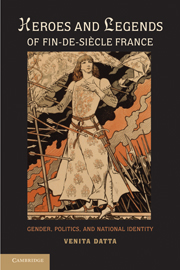Book contents
- Frontmatter
- Contents
- Acknowledgments
- Introduction: The Fin-de-Siècle Cult of Heroes
- 1 Gender, Class, and Heroism in the Bazar de la Charité Fire of 1897
- 2 Cyrano: A Hero for the Fin de Siècle?
- 3 “L'Appel au Soldat”: Visions of the Napoleonic Legend in Popular Culture
- 4 On the Boulevards: Representations of Joan of Arc in the Popular Theater
- 5 Opium, Gambling, and the Demimondaine: The Ullmo Spy Case of 1907–1908
- Conclusion: From One War to the Next: The End of Heroes?
- Selected Bibliography
- Index
1 - Gender, Class, and Heroism in the Bazar de la Charité Fire of 1897
Published online by Cambridge University Press: 05 June 2012
- Frontmatter
- Contents
- Acknowledgments
- Introduction: The Fin-de-Siècle Cult of Heroes
- 1 Gender, Class, and Heroism in the Bazar de la Charité Fire of 1897
- 2 Cyrano: A Hero for the Fin de Siècle?
- 3 “L'Appel au Soldat”: Visions of the Napoleonic Legend in Popular Culture
- 4 On the Boulevards: Representations of Joan of Arc in the Popular Theater
- 5 Opium, Gambling, and the Demimondaine: The Ullmo Spy Case of 1907–1908
- Conclusion: From One War to the Next: The End of Heroes?
- Selected Bibliography
- Index
Summary
At number 23, rue Jean-Goujon, just off the bustle of the Champs-Elysées, stands Notre-Dame de la Consolation, an imposing church built in the Louis XVI style. Even Parisians, if they were to find themselves on this quiet street around the corner from the métro stop Alma-Marceau, would be hard-pressed to know that the church was built on the site of what contemporaries of the fin de siècle viewed as one of the greatest disasters of the time. Reading the plaque at the entrance of the church, they would learn that Notre-Dame de la Consolation represents an ex-voto offering to the 125 victims, nearly all of them prominent women, who perished in the Bazar de la Charité fire on May 4, 1897.
Billed as the society event of the season, the Bazar de la Charité was a yearly charity bazaar patronized by wealthy aristocratic and bourgeois Catholic women. Founded in 1885 to raise money for Catholic organizations by entrepreneur Henry Blount and presided over by the Baron de Mackau, a leading Catholic politician who had rallied to the republic, the Bazar de la Charité was held in a common venue for an entire month. Its organizers and attendees, who were there by invitation only, represented, in the words of Le Matin, “the phone directory of the nobility and of ‘le Tout-Paris.’”
- Type
- Chapter
- Information
- Heroes and Legends of Fin-de-Siècle FranceGender, Politics, and National Identity, pp. 33 - 75Publisher: Cambridge University PressPrint publication year: 2011
- 1
- Cited by



